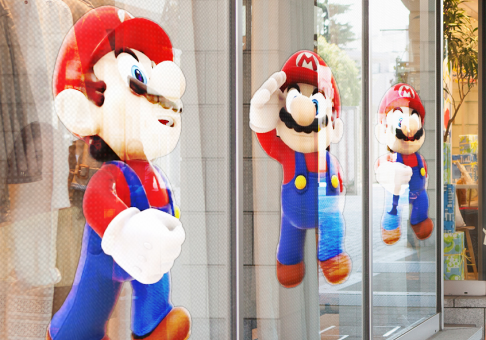The performance market continues to be hot, let’s see how MUXWAVE reshapes the entertainment industry
2023-12-25The visual experience is super doubled! LED display screen combined with digital technology will take the 2023 stage show to new heights!
2023-12-2601Energy saving and consumption reduction technology
Due to the adoption of an array control system, it can effectively reduce the loss of display brightness caused by the control system used to generate gray scale. According to comparative calculations, the system loss of the traditional “centralized control system” is between 30% and 40%. , the system loss of the “array control system” is between 8% and 10%. The reduction of the control system loss is conducive to improving the brightness of the display screen, or reducing the current of the display screen under the same brightness conditions, thereby achieving The effect of energy saving and consumption reduction.
The centralized control system, due to its large control range, has to reduce the number of scans and reduce the brightness to form grayscale in order to maintain a certain refresh rate; due to the small control range of the array control system, it can greatly increase the number of scans, and the brightness loss will follow. become smaller. The number of scans of the array system can reach more than 136 fields, while the maximum number of scans of the centralized system can reach 42 fields.
According to the principle of brightness loss, the calculation table is as follows: A 200 square meter outdoor full-color display with a specification of 3906 dots/square meter, if a drive current of 20mA is used, the theoretical maximum brightness can reach 15000cd/m2. If it is to reach 6000cd/m2 The maximum actual brightness is using a “centralized control system”. According to 30% system loss, the display driving current is 11.4mA/pixel, and the maximum power supply current is 607A; if an “array control system” is used, it can reach 6000cd / m2 maximum actual brightness, based on 10% system loss, the display driving current is 8.89mA/pixel, the maximum current is 474A, and the energy saving range reaches 21.9%. Calculated based on the average power consumption being 40% of the maximum power consumption, 10 hours of use per day and 300 days per year, the annual power consumption using the “centralized control system” is 160,248 kilowatt hours. The annual power consumption of the “array control system” is 125,136 kilowatt-hours, saving approximately 35,112 yuan/year (calculated based on 1.0 yuan per kilowatt-hour of electricity)
02Single point detection technology
In order to improve the reliability of the screen and increase the convenience of maintenance, MUXWAVE has specially developed a single-point detection technology for the display. Each IC controls a lamp bead. Usually, the detection of LED pixels before the LED display leaves the factory is through visual inspection (that is, the human eye (Watch whether it emits light according to the debugging program). When watching LED pixels for a long time, it is inevitable that there will be a certain degree of visual fatigue, missed or misjudged judgments, and the work efficiency is not high. Now our company uses the single-point detection function of the screen. You only need to run the corresponding program to determine the working status of the pixels and perform repairs, which greatly improves the reliability of the screen.
At the same time, with the continuous development of LED display technology, ultra-large LED screens have emerged on the market. This type of screen is generally installed at a higher position and has a longer viewing distance, which brings inconvenience to the inspection of the display screen. The judgment of each pixel can often only be based on human judgment. After using the single-point detection function, maintenance personnel can easily find the coordinates of the fault point and quickly replace it.
03 Single-point brightness and chroma correction technology
The issue of brightness and chromaticity uniformity of LED displays has always been a major problem that has troubled people in the industry. It is generally believed that uneven brightness of LEDs can be corrected at a single point to improve brightness uniformity, while uneven chromaticity cannot be corrected. It can only be improved by subdividing and filtering the LED color coordinates. As people’s requirements for LED displays are getting higher and higher, it is no longer possible to subdivide and filter LED color coordinates to satisfy people’s picky eyes. It is possible to comprehensively correct the display to improve the chromaticity uniformity.
First of all, the brightness and chromaticity at a certain level are inconsistent due to differences in the LEDs themselves (for example: using the same current to light up two green LEDs from the same production batch, the brightness may vary by 30%, and the wavelength may vary There will be a 10-15nm change). Secondly, after a period of use, the blue LED dims to the greatest degree and the red LED to the smallest degree. However, the biggest problem is that the LED dims to different degrees after a period of time.
Therefore, even if the consistency of the LED screen is perfect in the factory, the consistency will be lost as the LED dims, and the inconsistency of the LED screen will be significantly discovered after three years of continuous use. To this end, Yuanheng Optoelectronics uses the world’s most advanced monochromatic brightness and chromaticity correction technology (also known as: brightness and chromaticity signature technology) to solve the problem of inconsistent color rendering due to inconsistent attenuation of light-emitting diodes of different colors.
In terms of display technology, LCD is a display screen composed of liquid crystals, and LED is a display screen composed of light-emitting diodes. Each pixel unit in an LED digital display is a light-emitting diode. Monochrome LED displays are generally red light-emitting diodes.

